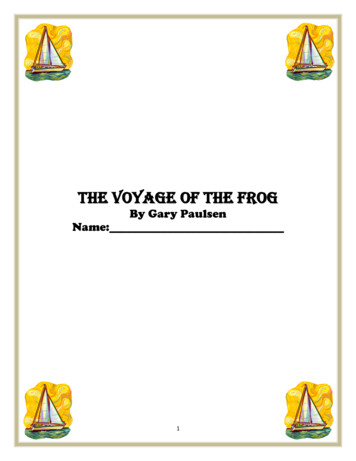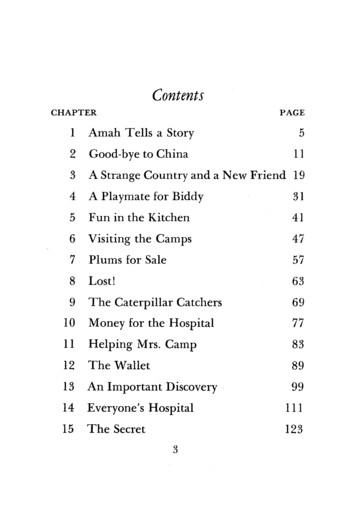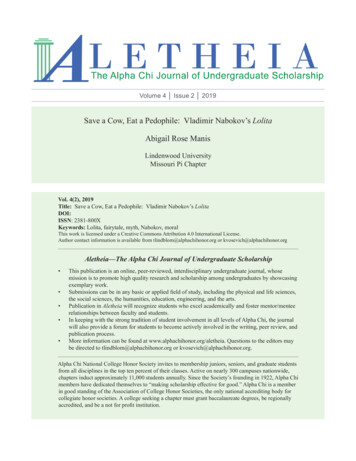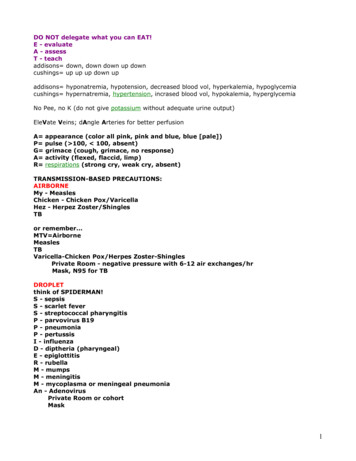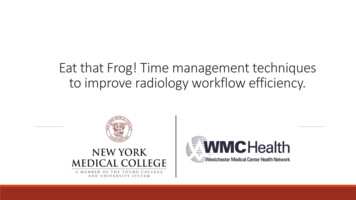
Transcription
Eat that Frog! Time management techniquesto improve radiology workflow efficiency.
Authors:Ajay Patel MD., Ross Myers MD., Jennifer Wu MD., Oliver Furusato-Hunt MD., William Gao MD.,Michelle LaRosa MD., Adele Brudnicki MD., Jared Meshekow MD MPH., Sam McCabe MD., PerryGerard MD, MBA, FACR.DISCLOSURE:WE HAVE NO ACTUAL OR POTENTIAL CONLICT OF INTEREST IN RELATION TO THISPRESENTATION.
Introduction:As the workload of clinical radiology continues to increase, it is becoming more and more crucial forradiology services to improve efficiency while maintaining and improving quality.Establishing or developing an efficient workflow may require unique adaptations to address the vastnumber of challenges and factors which must be considered to complete the day's work.One of the most famous books on productivity to date is "Eat That Frog!" by Brian Tracy, in which anumber of time management, motivations and productivity techniques are presented for generalizedtasks.Many of the concepts discussed may be applied to radiology services to improve workflow.
Concept behind “Eat that Frog!”“ if the first thing you do each morning is to eat a live frog, you can go through the day with thesatisfaction of knowing that that is probably the worst thing that is going to happen to you all daylong”– Mark TwainAuthor Brian Tracy adopted Mark Twain’s quote to describe a productivity technique in his book “EatThat Frog!: 21 Great Ways to Stop Procrastinating and Get More Done in Less Time”In the context of productivity, the frog represents an unpleaseant or difficult task which may beprone to procastination given the unpleasent nature of the task.Completing said task will not only progress past that particular task, but will allow for more efficienthandling of tasks to come.
Concept behind “Eat that Frog!”It has been found that multiple factors contribute to productivity and procrastination, includingintrinsic factors unique to the individual as well as external factors related to the tasks at hand.Completing the most challenging or unpleasent task, “eating the frog,” at the start of the work dayprovides the reassurance that the worst part of the day has been completed, as a result,one is morelikely to have a positive approach to the rest of the day.
How to “Eat the Frog”: first, find yourfrogIn order to apply the technique, one must pick their frog for the day.It is important to properly prioritize tasks and pick out the the most important tasksTracy devised a grading system to organize tasks on an ABCDE scale:A: A task that must be completed or else there will be serious consequences. These tasks are primecandidates to be selected as the frogs.B: A task which should be done but only has mild consequences if not done.C: A task which could be done, but there are no consequences at all for not doing it.D: A task you can delegate to someone else, freeing up more of your time for A tasks.E: tasks which do not have to be done and can be eliminated altogether with no real consequence.
How to “Eat the Frog”: Start eatingTake action immediately.“Failure to execute” has been identified as one of the greatest problems in organizations today.“If You Have to Eat Two Frogs, Eat the Ugliest one First”Do not stop until the task is completed.Completion of the most difficult task early in the day provides more time for enjoyable task later inthe day.Some theories support the notion that work is more productive at the start of a session, such as theattention decrement which posits primacy effect may allow for higher efficiency in the first tasks ofthe day. As a result it would stand to reason that the most difficult task should be handled at the timewhen one works with the greatest efficacy.
How to “Eat the Frog”: Frogs in radiologyThere are a number of tasks in a radiology service workflow which fall into the A grade. These tasksvary for each aspect of the service.While a radiologist may have a different list of priorities from a nurse, a CT technician, a residentradiologist or a referring physician, certain common values are always shared such as the care andmanagement of emergent patientsIt is often most important to place patients in the ER or stroke patients into the A/B category. Veryrarely will there be tasks higher in priority.Hosting common priorities can merge and align efforts across the entire department to provideefficient care
How to “Eat the Frog”: Tasks in radiologyIn addition to focusing the department’s efforts, identifying tasks for delegation and delegating saidtasks can greatly improve efficiency.As people work through their high priority tasks, other important task may be left unattended.However, if tasks which can be delegated are identified, it may be addressed quicker by anothermember of the department who has finished their tasks.Sharing and delegation of task in a coordinated fashion can save a great deal of time and completemore work in a given time.
“Eat the Frog”: potential pitfallsThe Eat the Frog technique as described by Tracy is a rigid system in which the user must exhibit agreat deal of discipline and compliance in completing a selected plan.While this may be without issue in some fields, the workflow in medicine is often unpredicatble withmany changing priorities. It may not be possible or acceptable to employ the technique in its originalrigid manner.For example, if you set out to complete a reviewing and dictating a complicated case in theemergency room, but a new time sensitive emergency arises during that time, it may not be wise todelay addressing the new case.A degree of flexibility must be incorporated into employing such a technique.
SummaryIdentifying and prioritizing tasks as important and delegating tasks among a radiology service canallow for greater efficiency in completing tasks.Starting with the most important/difficult task first can allow for that task to be addressed with moreefficiency than if it were addressed later in the day.Some flexibility must be incorporated into the Eat the Frog technique as the radioplogy work flowmay not allow for such a rigid adherence to the technique.Utilizing effective time management and productivity techniques can improve a radiology servicesefficiency, allowing radiologist to meet the increasing workload of clinical imaging withoutcompromising quality.
Sources:Solomon, L. J., & Rothblum, E. D. (1984). Academic procrastination: Frequency and cognitivebehavioral correlates. Journal of Counseling Psychology, 31(4), 503-509.Erik Peper, Richard Harvey, I-Mei Lin, and Padma Duvvuri. Increase Productivity, DecreaseProcrastination, and Increase Energy. Biofeedback 2014 42:2, 82-87Hendrick, Clyde, et al. "Attention decrement, temporal variation, and the primacy effect inimpression formation." Memory & cognition 1.2 (1973): 193-195.Tracy, Brian. Eat That Frog!: 21 Great Ways to Stop Procrastinating and Get More Done in Less Time.Barrett-Koehler Pub. Inc., 2017.
“Eat the Frog”: potential pitfalls The Eat the Frog technique as described by Tracy is a rigid system in which the user must exhibit a great deal of discipline and compliance in completing a selected plan. While this may be without issue in some fields, the workflow in medic

